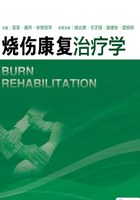
参考文献
1.王成,荣艳华,宁方刚,等.北京积水潭医院1974例烧伤住院患者流行病学调查.中华烧伤杂志,2014,30(1):91-92.
2.舒彬.临床康复工程学.北京:人民卫生出版社,2013.
3.吴军,陈建.关注患者生存质量展望烧伤康复未来.中华烧伤杂志,2013,29(2):116-118.
4.贾赤宇.浅谈我国儿童烧伤康复.中华烧伤杂志,2013,29(1):4-5.
5.陈向军,闫德雄,高国珍,等.15年间16 595例烧伤儿童资料分析.中华烧伤杂志,2013,29(1):6-10.
6.丁汉梅,谢卫国,吴红,等.烧伤康复患者出院后心理重建平台的构建.中华损伤与修复杂志(电子版),2012,7(2):203-205.
7.郭爱华.关于人皮肤真皮和角质上皮细胞以及在体创伤模型的研究.博士研究生论文,2012.
8.唐洪泰,马兵,夏照帆.重视火灾事故成批烧伤的救治.中华烧伤杂志,2012,28(3):161-164.
9.庞久玲,刘爱东,张静涛,等.心理护理干预对老年大面积烧伤患者领悟社会支持影响的临床研究.护士进修杂志,2011,26(12):1129-1131.
10.朱毅,励建安.烧伤康复的策略.中华烧伤杂志,2011,27(6):477-479.
11.舒彬.创伤康复学.北京:人民卫生出版社,2010.
12.黄跃生.烧伤外科学.北京:科学技术文献出版社,2010.
13.信文启,李新宇.毛细血管渗漏综合征治疗进展.现代生物医学进展,2010,10(14):2760-2762.
14.杜飞亚,谈伟强.瘢痕的形成机制及治疗研究进展.全科医学临床与教育,2010,8(05):528-530.
15.闫贵春,裴银辉.瘢痕发生机制研究进展.中国美容医学,2010,19(8):1251-1255.
16.南登崑,黄晓琳.实用康复医学.北京:人民卫生出版社,2009.
17.孙家驹.严重烧伤早期处理对全身炎症反应综合征的影响.中山大学学报(医学科学版),2009,30(4S):103-105.
18.南登崑.康复医学.北京:人民卫生出版社,2008.
19.蔡景龙.现代瘢痕学.北京:人民卫生出版社,2008.
20.姚咏明,盛志勇.脓毒症防治学.北京:科学技术文献出版社,2008.
21.杨立华,傅晓凤,傅颖梅,等.富硒温泉水浸渍对烧伤增生瘢痕的转化效应.中国组织工程研究与临床康复,2008,12(27):5309-5313.
22.覃霞,曹川,何梅,等.烧伤后皮肤色素沉着综合治疗的研究.重庆医学,2008,37(1):65-68.
23.尚新志,唐乾利,张力,等.280例老年烧伤住院患者流行病学调查.中华烧伤杂志,2008,24(2):128.
24.岳丽青,蒋冬梅,黄晓元.严重烧伤患者康复期社会支持调查及其影响因素的分析.护理研究,2008,22(8):2174-2175.
25.岳丽青,蒋冬梅,黄晓元.严重烧伤患者康复期生活质量调查及其影响因素分析.中华烧伤杂志,2008,24(3):195-198.
26.王正国.外科学与野战外科学.北京:人民军医出版社,2007.
27.黄桃英,石晓敏.低温可塑板材制作烧伤整形患者的功能康复支具.中国组织工程研究与临床康复,2007,11(26):5247.
28.陈向军,闫德雄,邢继平等.西北部分省区小儿烧伤的流行病学特点.中华烧伤杂志,2007,23(5):380.
29.李世荣.现代美容整形外科学.北京:人民军医出版社,2006.
30.杨宗城,盛志勇.烧伤治疗学.北京:人民卫生出版社,2006.
31.葛绳德,夏照帆.临床烧伤外科学.北京:金盾出版社,2006.
32.杨宗城.烧伤治疗学.第3版.北京:人民卫生出版社,2006.
33.廖镇江,方陪耀,史济湘.烧伤治疗学.杭州:浙江科学技术出版社,2006.
34.岳丽青.烧伤患者生活质量研究进展.中华护理杂志,2006,41(7):652-655.
35.沈华美,钱芳.大面积烧伤患者生活质量与社会支持的相关性调查分析.护士进修杂志,2006,21(11):1006-1007.
36.何梅,冯正直,张大均,等.烧伤患者住院期间自尊水平和社会适应能力调查分析.中华烧伤杂志,2006,22(4):288-290.
37.匡新建,陈伟高.成纤维细胞生物学特性与创伤修复的研究进展.实用诊断与治疗杂志,2005,19(12):890-892.
38.彭毅志.提高深Ⅱ度烧伤创面的处理水平.中华烧伤杂志,2005,21(1):12-13.
39.燕铁斌.现代康复治疗学.广州:广东科技出版社,2004.
40.李曾慧平,刘颂文,励建安.压力治疗及硅酮敷料治疗对增生性瘢痕疗效的短期研究.中华物理医学与康复杂志,2004,26(8):462-465.
41.金鸿宾.创伤学.天津:天津科学技术出版社,2003.
42.李荟元,鲁开化,郭树忠.新编瘢痕学.西安:第四军医大学出版社,2003.
43.陈艳清,李世荣,贾树蓉,等.超声波导入瘢痕康治疗增生性瘢痕的临床研究.中国临床康复,2003,7(17):2477-2478.
44.王怀奇,蔡体章.2180例烧伤流行病学调查报告.四川医学,2003,24(10):1091-1092.
45.赵克森,黄巧冰.血管通透性增高的基本机制.中国病理生理杂志,2003,19(04):118-122.
46.励建安,王彤.康复医学.北京:科学出版社,2002.
47.刘俊玲,邓津菊.中药面膜治疗皮肤烧伤后色素沉着和瘢痕增生.中国临床康复,2002,6(4):544.
48.李黎.烧伤患者精神障碍与重返社会工作的相关因素分析.中华烧伤杂志,2002,18(5):305-307.
49.杨凡.烧伤康复期患者社会支持和生存质量的相关因素分析.中国临床康复,2002,6(10):1407-1408.
50.谢有富,梁达荣.8920例烧伤患者流行病学资料分析.广东医学,2002,23(3):261-262.
51.金德闻,季林红,张培川.康复工程研究的新进展.中国康复医学杂志,2001,16(6):328-330.
52.杨宗城,汪仕良,周一平.实用烧伤外科手册.北京:人民军医出版社,2001.
53.乔志恒,范维铬.物理治疗全书.北京:科学技术文献出版社,2001.
54.盛志勇,郭振荣.危重烧伤治疗与康复学.北京:科学技术出版社,2001.
55.乔志恒,范维铬.物理治疗全书.北京:科学技术文献出版社,2001.
56.孙永华.功能与外貌恢复必须面对的现实问题.中华烧伤杂志,2001,17(6):325-326.
57.尹婧.皮肤烧伤的流行病学现况.疾病控制杂志,2001,5(3):236-238.
58.彭毅志,肖光夏.42年严重烧伤全身性感染的防治经验.中华烧伤杂志,2001,17(2):93-95.
59.周一平.50年来我国成批烧伤救治的回顾.中华烧伤杂志,2000,16(1):17-18.
60.仇旭光,王野平,蒋金衍.近5年烧伤住院患者流行病学调查.浙江医学,1999,21(3):64-66.
61.方勇,龚永生,陈玉林.664例小儿烧伤流行病学统计分析.中华整形烧伤外科杂志,1999,15(5):387-388.
62.柴家科,盛志勇,高建川,等.111例烧伤脓毒症的发生特点及转归.中国危重病急救医学,1999,11(12):721-724.
63.付琼芳,杨宗城,阵发明,等.犬烧伤休克早期延迟输液对肺功能的影响.中华创伤杂志,1996,12(02):42-44.
64.杨志杰.超声治疗瘢痕疗效观察.中华理疗杂志,1995,18(2):98.
65.Ao,L,Yaosheng,H,Ning,Z,et al.64 320例烧伤患者的分析.解放军医学杂志,1995,20(01):3-9.
66.肖水源.社会支持评定量表.中国心理卫生杂志,1993,7(增刊):42.
67.钟敏华,赵崇华.国内84家医院9695例电烧伤患者流行病学资料分析.中华整形烧伤外科杂志,1993,9(6):417-418.
68.方子扬,吴中立,高学书.烧伤理论与实践.沈阳:辽宁科学出版社,1989.
69.第三军医大学烧伤防治研究协作组.烧伤治疗学.北京:人民卫生出版社,1977.
70.Ahmad,I.,et al.Aspects of sexual life in patients after burn:the most neglected part of postburn rehabilitation in the developing world.J Burn Care Res,2013,34(6):p.e333-341.
71.Cowan,A.C.and C.W.Stegink-Jansen,Rehabilitation of hand burn injuries:current updates.Injury,2013,44(3):p.391-396.
72.Bergkamp,D.,et al.Effectiveness of a burn rehabilitation workshop addressing confidence in therapy providers.JBurn Care Res,2013,34(1):p.e10-14.
73.Chen,J.,et al.A survey on the current status of burn rehabilitation services in China.Burns,2013,39(2):p.269-278.
74.Schneider,J.C.,etal.The impact of comorbidities and complications on burn injury inpatient rehabilitation outcomes.PM R,2013,5(2):p.114-121.
75.Wu,J.and J.Chen,[Pay close attention to the quality of life of patients and look to the future of burn rehabilitation].Zhonghua Shao Shang Za Zhi,2013,29(2):p.119-121.
76.David N.Herndon.Total Burn Care(4th Edition).Saunders,2012.
77.Yohannan,S.K.,et al.Burn survivors’perceptions of rehabilitation.Burns,2012,38(8):p.1151-1156.
78.Mason,S.T.,et al.Return to work after burn injury:a systematic review.JBurn Care Res,2012,33(1):p.101-109.
79.Foyatier,J.L.,et al.[Face rehabilitation for post-burn deformities].Ann Chir Plast Esthet,2011,56(5):p.388-407.
80.Rafla,K.and E.E.Tredget,Infection control in the burn unit.Burns,2011,37(1):p.5-15.
81.Maslow,G.R.and D.Lobato,Summer camps for children with burn injuries:a literature review.J Burn Care Res,2010,31(5):p.740-749.
82.Chipp,E.,C.S.Milner and A.V.Blackburn,Sepsis in burns:a review of current practice and future therapies.Ann Plast Surg,2010,65(2):p.228-236.
83.Phillips,C.and N.Rumsey,Considerations for the provision of psychosocial services for families following paediatric burn injury—a quantitative study.Burns,2008,34(1):p.56-62.
84.Costa,M.C.,et al.Themeanings of quality of life:interpretative analysis based on experiences of people in burns rehabilitation.Rev Lat Am Enfermagem,2008,16(2):p.252-259.
85.Dellinger,R.P.,et al.Surviving Sepsis Campaign:international guidelines formanagement of severe sepsis and septic shock:2008.Crit Care Med,2008,36(1):p.296-327.
86.Pham,T.N.,L.C.Cancio and N.S.Gibran,American Burn Association practice guidelines burn shock resuscitation.J Burn Care Res,2008,29(1):p.257-66.
87.Singer,A.J.and A.B.Dagum,Currentmanagement of acute cutaneouswounds.N Engl JMed,2008,359(10):p.1037-1046.
88.Greenhalgh,D.G.,etal.American Burn Association consensus conference to define sepsis and infection in burns.JBurn Care Res,2007,28(6):p.776-790.
89.Guarneri,C.,et al.,The future:critical knowledge about anti-itch therapy.Dermatol Ther,2005,18(4):p.363-365.
90.Peng,Y.,Z.Yuan and H.Li,Removal of inflammatory cytokines and endotoxin by veno-venous continuous renal replacement therapy for burned patients with sepsis.Burns,2005,31(5):p.623-628.
91.Xie,Y.,Y.Tan and S.Tang,Epidemiology of 377 patients with chemical burns in Guangdong province.Burns,2004,30(6):p.569-572.
92.Wiechman,S.A.,et al.Rates,trends,and severity of depression after burn injuries.JBurn Care Rehabil,2001,22(6):p.417-424.
93.Yoshimura,K.,et al.Experience with a strong bleaching treatment for skin hyperpigmentation in Orientals.Plast Reconstr Surg,2000,105(3):p.1097-108;discussion 1109-1110.
94.Costa,A.M.,et al.Mechanical forces induce scar remodeling.Study in non-pressure-treated versus pressure-treated hypertrophic scars.Am J Pathol,1999,155(5):p.1671-1679.
95.McHugh,A.A.,et al.Biomechanical alterations in normal skin and hypertrophic scar after thermal injury.JBurn Care Rehabil,1997,18(2):p.104-108.
96.Tanttula,K.,J.Vuola and S.Asko-Seljavaara,Return to employment after burn.Burns,1997,23(4):p.341-344.
97.Johnson,J.,et al.Compliance with pressure garment use in burn rehabilitation.J Burn Care Rehabil,1994,15(2):p.180-188.
98.Burnsworth,B.,M.J.Krob and M.Langer-Schnepp,Immediate ambulation of patientswith lower-extremity grafts.JBurn Care Rehabil,1992,13(1):p.89-92.
99.Salisbury,R.,Burn rehabilitation:our unanswered challenge.The 1992 presidential address to the American Burn Association.JBurn Care Rehabil,1992,13(5):p.495-505.
100.Schmitt,M.A.,L.French and E.T.Kalil,How soon is safe?Ambulation of the patient with burns after lower-extremity skin grafting.JBurn Care Rehabil,1991,12(1):p.33-37.
101.Thomsen,M.,Itall began with Aristotle—the history of the treatment of burns.Burns Incl Therm Inj,1988,Suppl:p.41-46.
102.Walls,R.D.,Camp Celebrate:a therapeutic weekend camping program for pediatric burn patients.J Burn Care Rehabil,1986,7(5):p.434-436.
103.Feller,I.,et al.The team approach to total rehabilitation of the severely burned patient.Heart Lung,1973,2(5):p.701-706.